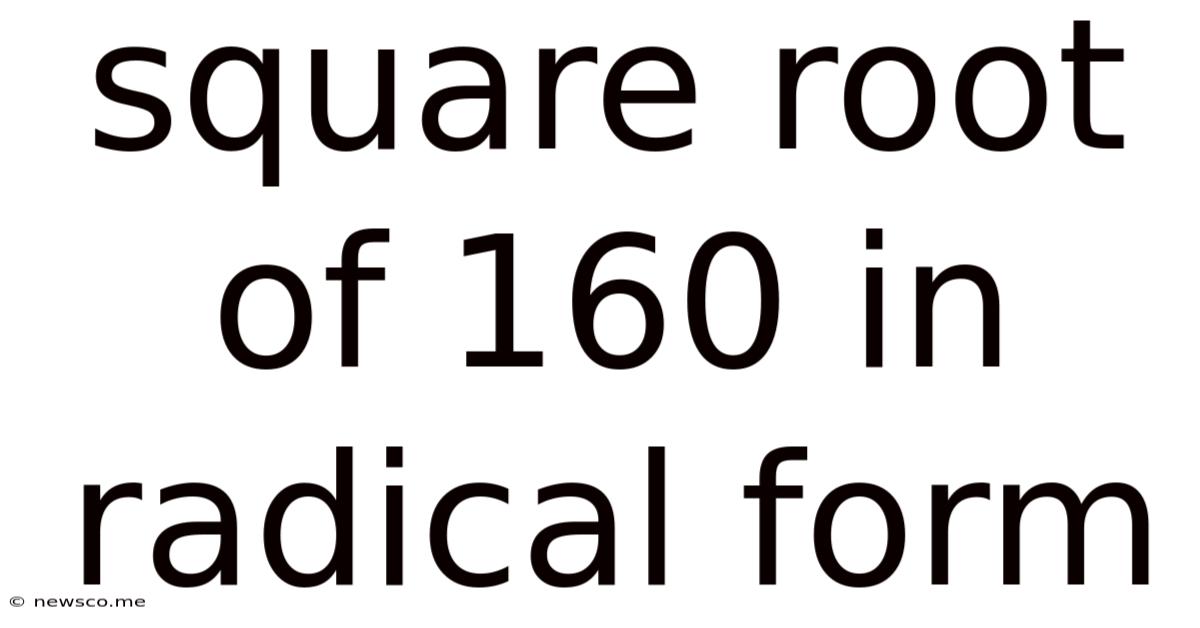Square Root Of 160 In Radical Form
News Co
Apr 14, 2025 · 5 min read

Table of Contents
Square Root of 160 in Radical Form: A Comprehensive Guide
The square root of 160, denoted as √160, isn't a perfect square. This means it can't be expressed as a whole number. However, we can simplify it into a radical form, expressing it as a product of a whole number and a radical. This process involves finding the prime factorization of 160 and then simplifying the resulting expression. This guide will take you through the process step-by-step, explaining the underlying mathematical concepts and offering several examples to solidify your understanding.
Understanding Square Roots and Radical Form
Before delving into the simplification of √160, let's clarify the fundamental concepts. A square root of a number is a value that, when multiplied by itself, equals the original number. For instance, the square root of 9 (√9) is 3, because 3 x 3 = 9.
Radical form refers to expressing a number as a root (like a square root, cube root, etc.) multiplied by a whole number (or sometimes another radical). It's a way of representing numbers that are not perfect squares (or cubes, etc.) in a simplified, manageable way.
Prime Factorization: The Key to Simplification
The cornerstone of simplifying square roots is prime factorization. This involves breaking down a number into its prime factors – numbers that are only divisible by 1 and themselves (e.g., 2, 3, 5, 7, 11, etc.). To find the prime factorization of 160, we can use a factor tree:
160
│
├── 10 x 16
│ │ │
│ ├── 2 x 5 ├── 2 x 8
│ │ │ │
│ │ │ ├── 2 x 4
│ │ │ │ │
│ │ │ │ └── 2 x 2
This shows us that the prime factorization of 160 is 2 x 2 x 2 x 2 x 2 x 5, or 2<sup>5</sup> x 5.
Simplifying √160
Now, let's use the prime factorization to simplify √160:
√160 = √(2<sup>5</sup> x 5)
Remember that √(a x b) = √a x √b. This property allows us to separate the terms:
√(2<sup>5</sup> x 5) = √(2<sup>4</sup> x 2 x 5) = √2<sup>4</sup> x √(2 x 5)
Since √2<sup>4</sup> is simply 2<sup>4/2</sup> = 2<sup>2</sup> = 4, we can further simplify:
4√(2 x 5) = 4√10
Therefore, the simplified radical form of √160 is 4√10.
Practical Applications and Examples
Understanding the simplification of square roots is crucial in various mathematical fields, including:
- Algebra: Simplifying expressions involving radicals.
- Geometry: Calculating lengths and areas involving irrational numbers.
- Calculus: Evaluating limits and integrals.
- Physics: Solving problems involving distances and velocities.
Let's explore some additional examples to reinforce the concept:
Example 1: Simplifying √72
- Prime Factorization: 72 = 2 x 2 x 2 x 3 x 3 = 2<sup>3</sup> x 3<sup>2</sup>
- Simplification: √72 = √(2<sup>3</sup> x 3<sup>2</sup>) = √(2<sup>2</sup> x 2 x 3<sup>2</sup>) = √2<sup>2</sup> x √3<sup>2</sup> x √2 = 2 x 3 x √2 = 6√2
Therefore, √72 simplifies to 6√2.
Example 2: Simplifying √128
- Prime Factorization: 128 = 2 x 2 x 2 x 2 x 2 x 2 x 2 = 2<sup>7</sup>
- Simplification: √128 = √(2<sup>7</sup>) = √(2<sup>6</sup> x 2) = √2<sup>6</sup> x √2 = 2<sup>3</sup>√2 = 8√2
Therefore, √128 simplifies to 8√2.
Example 3: Simplifying √200
- Prime Factorization: 200 = 2 x 2 x 2 x 5 x 5 = 2<sup>3</sup> x 5<sup>2</sup>
- Simplification: √200 = √(2<sup>3</sup> x 5<sup>2</sup>) = √(2<sup>2</sup> x 2 x 5<sup>2</sup>) = √2<sup>2</sup> x √5<sup>2</sup> x √2 = 2 x 5 x √2 = 10√2
Therefore, √200 simplifies to 10√2.
Advanced Concepts and Considerations
While the above examples cover basic simplification, some scenarios require more advanced techniques:
-
Adding and Subtracting Radicals: You can only add or subtract radicals if they have the same radicand (the number inside the square root). For example, 2√5 + 3√5 = 5√5, but 2√5 + 3√2 cannot be simplified further.
-
Multiplying and Dividing Radicals: When multiplying radicals, you multiply the numbers outside the radical and the numbers inside the radical separately. When dividing, you divide similarly. For example: (2√5) x (3√2) = 6√10 and (6√10) / (2√5) = 3√2
-
Rationalizing the Denominator: This involves eliminating radicals from the denominator of a fraction. This is achieved by multiplying both the numerator and the denominator by the conjugate of the denominator (e.g., if the denominator is a-√b, multiply by a+√b).
These advanced concepts build upon the foundational understanding of prime factorization and radical simplification.
Conclusion: Mastering Radical Simplification
Simplifying square roots, like finding the radical form of √160, is a fundamental skill in mathematics. By mastering prime factorization and applying the principles outlined in this guide, you can effectively simplify various radical expressions. This skill is not just about manipulating numbers; it’s about developing a deeper understanding of mathematical relationships and applying those relationships to solve complex problems across diverse fields. Remember to practice regularly, and don't hesitate to revisit these examples and explanations whenever needed. The key is consistent practice and a clear understanding of the underlying mathematical concepts. With enough practice, you'll be simplifying radicals with ease and confidence.
Latest Posts
Related Post
Thank you for visiting our website which covers about Square Root Of 160 In Radical Form . We hope the information provided has been useful to you. Feel free to contact us if you have any questions or need further assistance. See you next time and don't miss to bookmark.